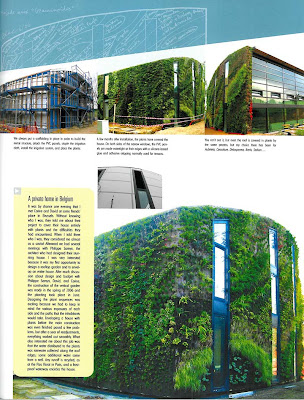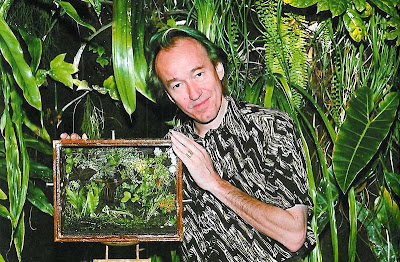The time has come. The fine folks at publisher WW Norton were nice enough to send me a review copy of The Vertical Garden: From Nature to The City, by Patrick Blanc about a month ago, and I’ve finally finished it off – at least for the most part. Suffice it to say – and I’ve done so already – that you will not be disappointed.
:: image via WW Norton
While the previous thumbnail image is small, the book is NOT. It’s huge – as in 11×14 color… as in won’t-fit-in-my-shoulder-bag-during-bike-to-work-challenge-month sort of huge… This coffee-table sized tome (is literally dripping with photos and imagery of the collected works, as well as words, sketches, and in process information). It is priced at $60, but I’d say due to the dearth of resources out there, Norton could’ve gone for $80-100 and it’d still jump off the shelves – maybe just so people could grab a magnifying glass and figure out some of the plantings on the plans:
:: plant list & plan from inside cover
From WW Norton: “From the inventor of the vertical garden, here are the secrets of plants that cling, grip and climb. Patrick Blanc, an artist with green fingers, has created dozens of his admired botanical tapestries in public and private spaces around the world, including the Marithé & François Girbaud boutique in Manhattan; the Jean Nouvel-designed Quai Branly Museum in Paris; the aquarium in Genoa; the Siam Paragon mall in Bangkok; and the 21st Century Museum of Contemporary Art in Kanazawa, Japan. In this luscious, oversize, all-colour book, he explains how to create plant walls using more than one thousand plants, drawing on his observation of natural milieus, his technique of growing on vertical surfaces, his savoir faire and his passion for plants.”
Ok, so Blanc IS the poster-child of the artform, with the floral print shirts and green hari, but he’s NOT the ‘inventor’ of the vertical garden as stated above. He’s just done a much better and more botanically and painterly amazing job of following through on implementation and success at a a scale that most designers merely salivate at… and most wonder HOW, not, I wish I had done this. Myself included.
So let’s take a peek inside. (All subsequent images are scans from the book, courtesy and copyright the publisher and authors…) The book contains a good overview in the Introduction on the Origins of Vertical Gardens, from that is mandatory reading. One excerpt will do to give a taste of the thought, research, and iterative trial and error that has gone into this work (p. 9).
“The last stage was perhaps the most decisive: I thought of using the textiles normally placed horizontally in greenhouses in order to maintain a certain humidity around the potted plants. A simple test with a lighter’s flame proved that the fibers of these recycled fabrics were synthetic, and therefore rot-proof. I purchased these unwoven textiles, called ‘irrigation lining,’ to replace my cotton floor cloth. Everything was perfect. That must have been around 1977. Thirty years later, I have remainded faithful to that solution and my oldest vertical garden is now twenty-five years old, even surviving a move. Since then, my work on vertical gardens has evolved, not through continued experimentation, but by approximating through observation and imagination my perpetual immersions among the world’s natural environments.”
The opening chapter continues this look at Natural Analogs, including ecosystems and sites that provide the specific rooting and moisture regimes that Blanc has adapted, such as Waterfalls, seeps, and caves. Also, there is a look at particular species groupings that are well adapted to this type of installation, such as ephiphytes.

:: Waterfalls as Inspiration
:: Cliff-dwelling plants
:: Ephiphytes in Tropical Rain Forest
Chapter 2 continues with an interesting diversion (I think) into ‘The Impact of Plants on Architecture’. In this section, Blanc outlines some of the positive and negative aspects of building / landscape interactions… pretty much as what to do/not to do in Veg.itecture. Not comprehensive and definitely applied more to tropical and natural settings versus urban installations – but fascinating reading all the same.

:: Strangler Ficus eats House in Angkor
Chapter 3 gets to the meat of the discourse -and provides what can be described as much leading of horse to water as Blanc could probably endure… More trial and error. More explanations. More wondering why we are all making this so incredibly hard still 🙂 There is a great chronology, specifically Blanc’s work with Jean Nouvel – which put the work on the map with Musee du Quai Branly in Paris – in 2006…

:: Musee du Quai Branly
And the big tell is of course, does Monsieur Blanc tell all about how to make these artful vegetal sculptures? Well, sort of… there are ample diagrams and descriptions (like this one below) of varying points in the construction process – enough for even mortals to figure it out. But can we all be Patrick Blanc? Alas, no… and I will tell you why in three major points.
:: Process Photos of Private Home in Belgium
First, you have to be a scientist and botanical genius. As many know, Blanc is affiliated with the CNRS (Centre National de Recherche Scientifique) and also won the French Society Award for Botany in 1993. The guy knows what he is doing, and is also very good at making these things work.

:: Blanc – in his natural habitat
Second, you have to have clients with shit-tons of money. Seriously, there’s always many ways to skin a cat, but you CAN NOT, do Quai Branly, or Caixa Forum with a client that is worried about SF costs or budget overruns. It’s art – and you can put a price tag on it, but it’s a sizable one. Deal with it. If you have a problem with it, then plant some Clematis on a piece of welded wire screen and be happy. Working with Jean Nouvel or Herzog & de Meuron is a plus…

:: Caixa Forum Madrid Planting Scaffold
Third, you have to boil this down to the very essence, or, in the words of Mr. Blanc himself: “Is it really necessary to expound at length on the way to attach a floor cloth to a plastic board with a hose connected on the top?” At this point, after cursing the Frenchman, and myself, a bit, I understood. We definitely like to complicate all of these technologies, create systems, and talk about it a lot, preferably at $100 and hour. Trial and error had allowed Blanc to simplify this technology and make it work, period. Can it be copied? Maybe. Can the knowledge be gleaned and applied. Absolutely! By just anyone? Doubtful. 
:: Les Halles Avignon
Alas our connundrum… as designers and innovators – how do we deal with the excitement and wow-factor that has been giving people goosebumps for the past few years? A client comes up and says ‘I want this.’ Can you do it? Most would say no? Some crazy ones – the few who took the leap when people starting doing green roofs in the US – or try to integrate new ideas into projects every time – not just when the planets align on that once in a lifetime project – they can use this book as a guide – try, fail, and learn… and begin to replicate and expand on Blancs work. It’s not revolutionary. It’s not proprietary (athought patented). It’s just really smart and simple.
The final section is a compendium of his Works, of which I will give a glimpse of a few, but you’ve seen a good number of these before on the web (but not in glossy 11×14″ color…)
:: Cultural Forum – Le Blanc-Mesnil

:: 21st Century Museum of Contemporary Art – Kanazawa
Blanc’s office is located out of Paris, and you can find much more info from his great website, The Vertical Garden by Patrick Blanc. Also, check out a short blurb from the NY Times last week about the book… haven’t seen other reviews, but will post when I do.
But you don’t need to read this or any other review. Just go buy the book. Now! It’s what you wanted to do, and it will both humble you and make you happy… what could be better for a mere $60?
